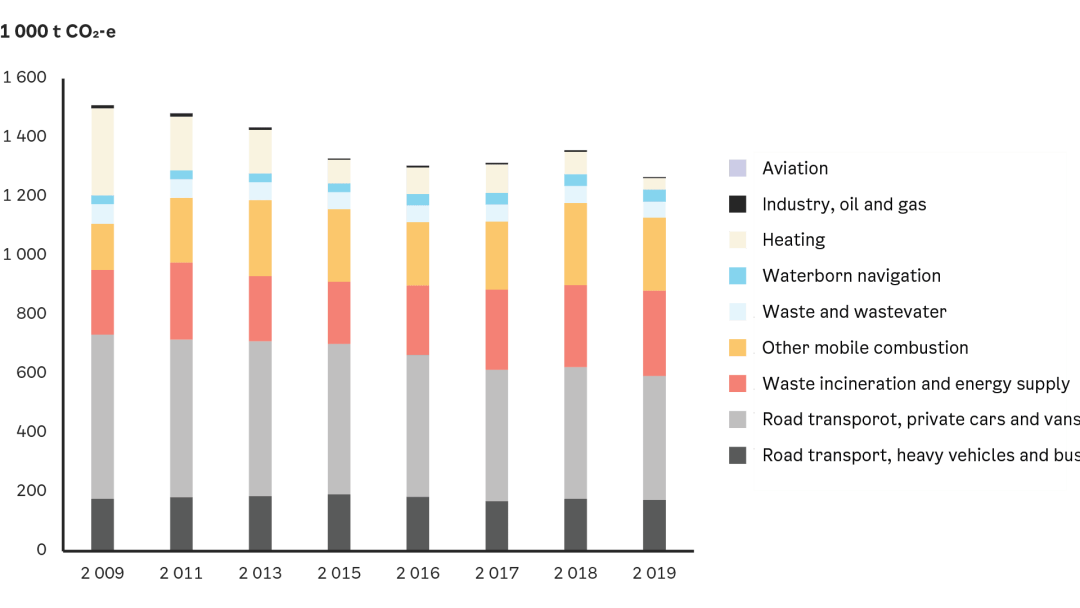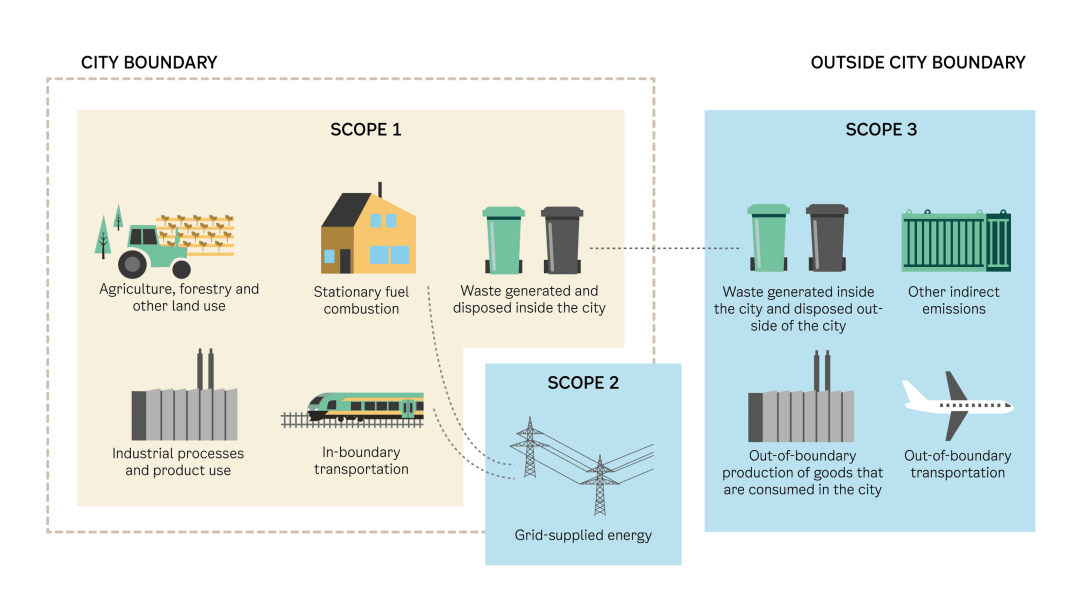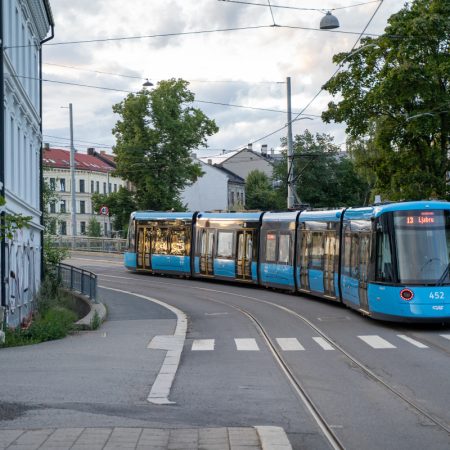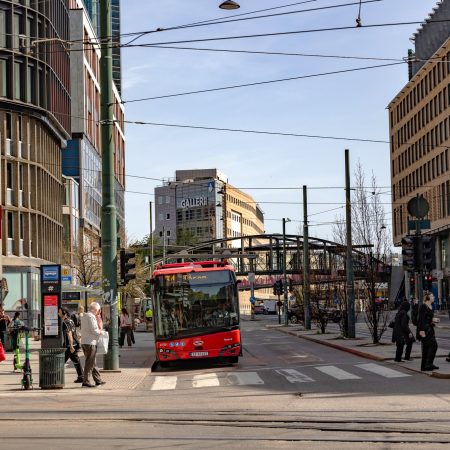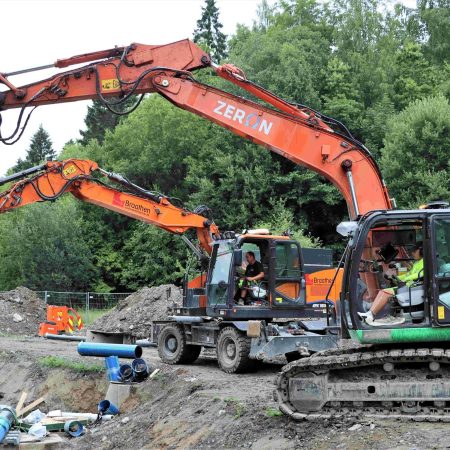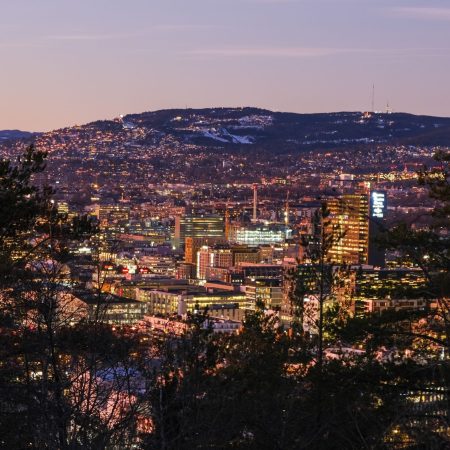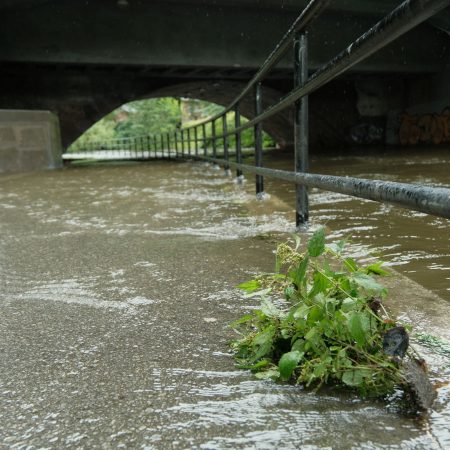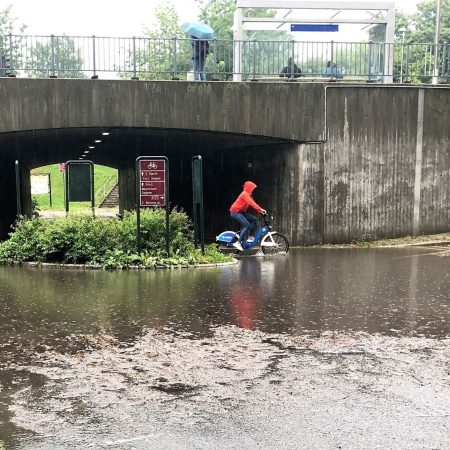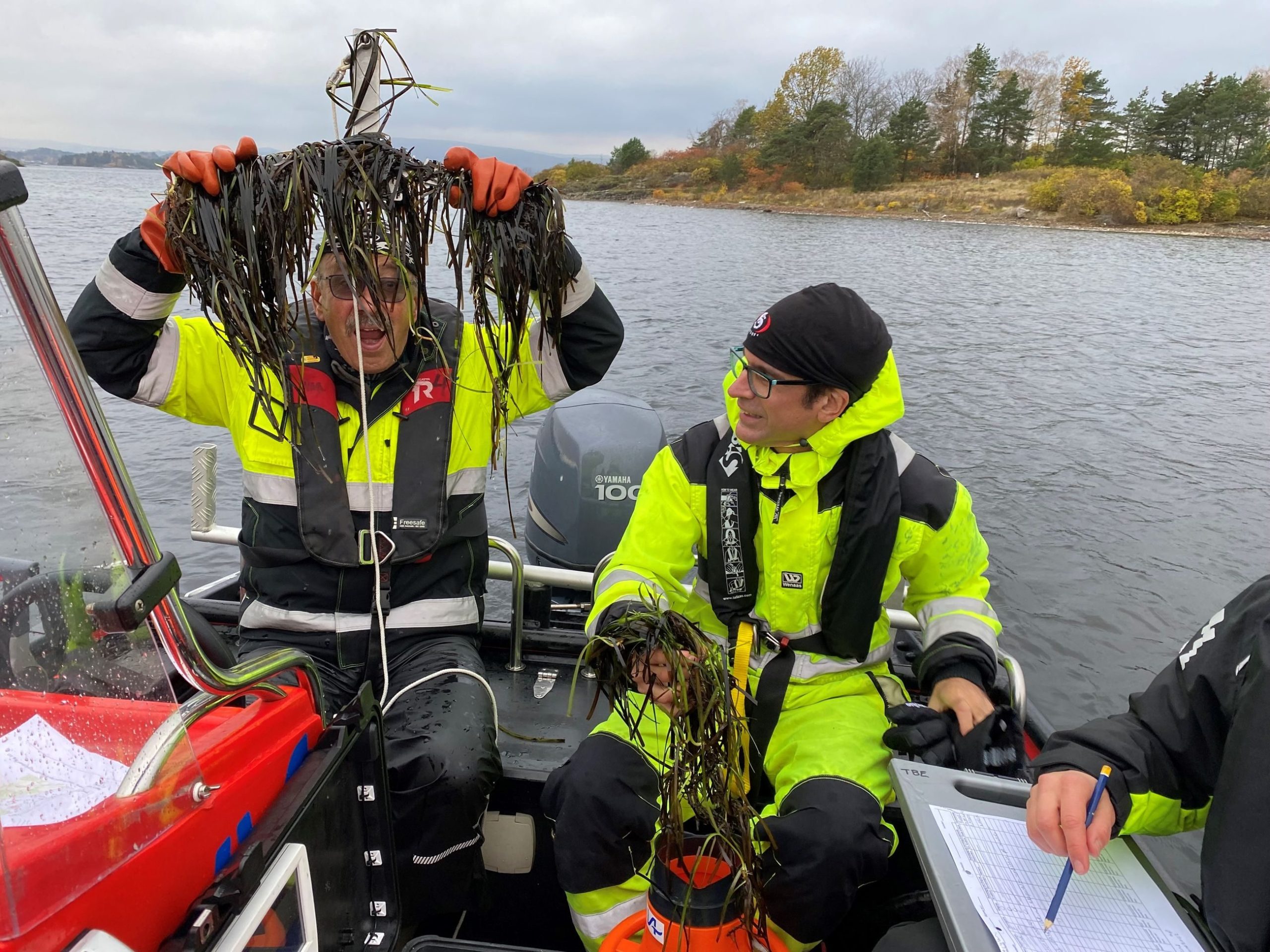Size: x-small
Type: color
Oslo’s Climate Budget 2022
2.5 Calculation of the impacts of measures 2022-2025
The Climate Agency has estimated the impacts of the measures in the Climate budget (Table 2.2.a). Impact calculations for measures in the Climate budget are based on a projection of Oslo’s emissions through to 2030 without any additional measures (the baseline scenario). This projection was prepared by the Centre for Climate Research (CICERO) and is based on the best available knowledge regarding the drivers that will impact on GHG emissions through to 2030.
The projection is subject to considerable uncertainty, partly because of the difficulty of making accurate predictions regarding technological advances which will impact on emissions. Further information regarding methodology and the basis for the calculations can be found in Chapter 2 of the Appendix to the 2022 Climate Budget.
The coronavirus pandemic has so far had major consequences for Oslo. The pandemic has influenced the behaviour of both inhabitants and businesses in Oslo and Norway generally. This behavioural change could impact on emission levels in both the short and the longer term. However, we do not know enough about the restructuring impacts of the coronavirus pandemic, or what will become the «new normal», to include such impacts in the Climate budget’s analyses this year.
2.5.1 Overall impact of measures
The analyses underlying this budget proposal show that the projected emission trends in Oslo, including the impact-assessed measures in the Climate budget, could cut GHG emissions by 26 % in 2022 and by 31 % in 2025, compared with 2009 levels (the dotted green line in the figure below).
A new feature in the 2022 Climate Budget is that emissions reductions are also estimated for measures politically adopted at either central government or municipal level which have not been quantified in Table 2.2a, because the basis for the figures is more uncertain or because of uncertainty regarding when the measure will be implemented (e.g. carbon capture at Klemetsrud).
Measures in this category are:
- Requirements regarding fossil-free construction sites in all new zoning plans (measure 24, Table 2.2b)
- Measure to reduce emissions from road transport (measures 17, 18, 20, 21 and 23, Table 2.2b)
- Zero-emission motorised equipment (measure 26, Table 2.2b)
- Ban on the use of mineral oil for temporary heating (central government) (measure 27, Table 2.2b)
- Carbon capture and storage at Klemetsrud from 2026 (from Table 2.3)
Of these, carbon capture at Klemetsrud will have the greatest impact and will contribute to the decrease in emissions from 2025 to 2026. The requirement for fossil-free and zero-emission construction sites will also have a significant impact towards 2026, and will result in a reduction in emissions almost as large as that from carbon capture in 2030. In the figure, these measures are referred to as “Adopted measures with uncertain calculations” (hatched darker green area in the figure below). If the impact of these measures is included, the total reductions in emissions are estimated to be 28 % in 2022, 39 % in 2025 and 62 % in 2030.
There is considerable uncertainty associated with the Norwegian Environment Agency’s emission inventory for 2009-2019, the emission projections and the projections concerning the impact of measures.
2.5.2 More about measures in the palest hatched green area
The measures referred to as “New measures under consideration”, are measures which have either been adopted or are the subject of a declaration of intent in the Climate strategy and elsewhere, but where the scope has not been clarified locally and/or nationally. These are measures that are being studied/planned at either local or national level. The final form of the measures could change the emission cuts specified below. The measures have been included to illustrate that a number of climate measures which could contribute to attainment of the climate target for 2030 are currently under development.
These measures include an extended zero-emission zone within Ring 2 from 2026, a gradual increase in prices in the road toll payment system for fossil fuel vehicles (Norconsult concluded that the largest reduction in emissions will be achieved with a price increase of NOK 100 for fossil fuel vehicles per passage compared with zero-emission vehicles in 2030), a carbon tax equivalent to NOK 2,000 in 2030 (without any compensation in the form of reductions in road use tax, etc.), according to the Norwegian government’s Climate Plan, and an increase in the biofuel sales requirement to 40 % in road transport in 2030, also according to the Norwegian government’s Climate Plan. In addition, there is a reduction in emissions linked to the municipality’s incineration of household waste through to 2030, although we have not yet adopted specific measures to eliminate these emissions.
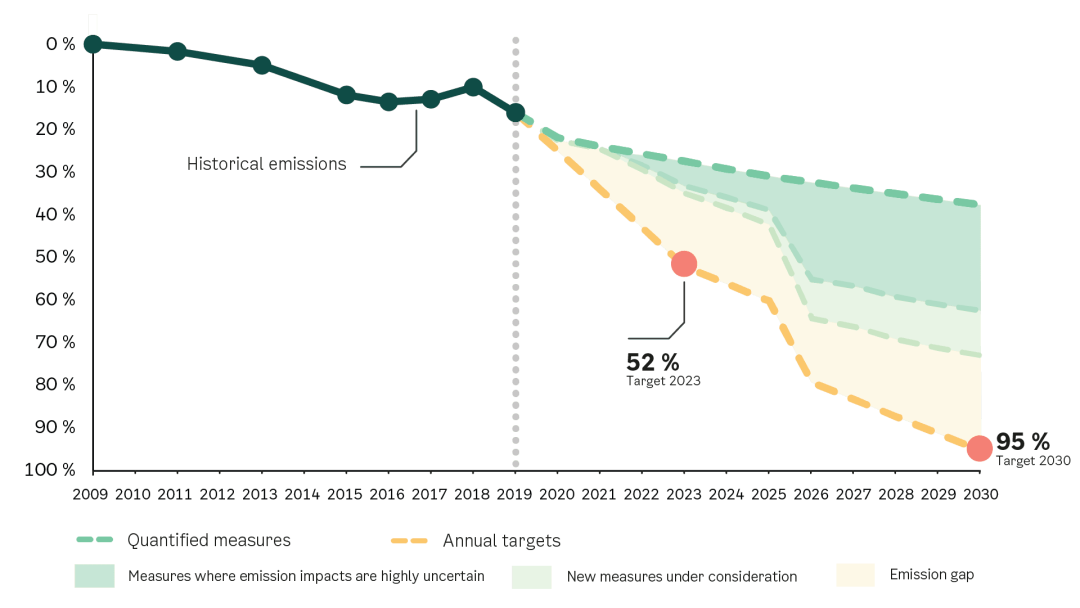
Figure 3: The figure shows emission projections towards 2030 based on adopted, quantified measures and instruments (dotted green line) and adopted measures and instruments with uncertain calculations (hatched green area). The pale green hatched area shows measures under conciderations.. The figure also shows necessary emission reductions to achieve the climate target in 2030 (annual targets), and the need to strengthen existing and develop new instruments (pale yellow hatched area)
As the figure above shows, the adopted and ongoing climate work could result in a 72 % reduction in emissions in 2030. In order to achieve the 2030 target, it will be necessary to work purposefully in order to reinforce existing measures and implement new ones. This also assumes that additional national measures will be implemented. There is a difference of 23 percentage points between adopted measures and declarations of intent, and the emissions limit in 2030. If the City Council does not support the identified measures, other measures which are at least as vigorous must be implemented to compensate for this. Despite the very high level of ambition in Oslo’s target for 2030, the city can achieve this target given these prerequisites.
No emission inventory is available for 2020, but the City Government’s 2020 annual report included a warning that the 2020 target was unlikely to be achieved. In the 2022 Climate budget, the City Government is proposing an emissions limit which starts from the last known emission inventory and then proceeds linearly to the target 52 % emission reduction in 2023 and on down to the target of a 95 % reduction in emissions in 2030.
As the figure above shows, it will be very challenging to achieve the target for 2023. Nevertheless, it is still possible to implement additional measures or raise the level of ambition for existing measures. The measures that are implemented may also have a greater or earlier impact than expected, and any improvement in the Norwegian Environment Agency’s emission inventory could more accurately reflect the impact of many key measures in Oslo. These factors could have a major impact on both the calculation of goal attainment and when the goal is attained.
In order to close the emission gap towards both 2023 and 2030, we will be dependent on the climate impacts of a strengthened national policy and the further climate-related efforts of the business community. The Norwegian government must eliminate barriers which prevent emission cuts in the major cities and reinforce the use of instruments in addition to what is set out in the government’s Climate Plan, such as:
- Ensure a national system that creates a climate impact for sustainably produced biofuels over and above the sales requirement, so that Norway achieves 1-2 million tonnes of additional emission reductions through to 2030.
- Introduce an exemption in the road toll ring for trucks powered by biogas. This was adopted by the Oslo Package 3 partnership 2.5 years ago, but the government has still not ensured its introduction. The exemption is likely to lead to a significant increase in the number of biogas-powered cars and more secure sales for the gas for biogas producers.
- Increase purchase taxes for fossil fuel cars, including rechargeable hybrid cars, to ensure that the target of selling 100 % zero-emission cars in 2025 is achieved.
- Ensure that the tax rules for the leasing of cars stimulate the leasing of electric cars rather than fossil fuel cars.
- Continue the Klimasats grant scheme and increase the subsidy to NOK 1 billion, in order to continue to stimulate innovative climate measures around the Norwegian municipalities.
- Secure regulations which permit municipalities to require charging for private parking, e.g. at workplaces, in order to encourage a modal shift to public transport, walking and cycling for travel to/from work.
All these central government instruments will help to close the gap in the pale-yellow hatched area.
2.5.3 Proposed resolution
The City Council shall strive to achieve the emissions limit year by year in order to achieve the 2030 target, and must therefore actively work to ensure the implementation of both the measures that cannot be quantified with sufficient certainty and the measures that are in process, and develop new and strengthen existing instruments. The 2022 Climate Budget concerns the economic plan period 2022-2025 and is intended to help to steer towards the climate target for 2030.
| 2009 (year of baseline) | 2019 (inventory) | 2022 | 2025 | |
|---|---|---|---|---|
| Historical emission reduction | 0 % | 16 % | – | – |
| Quantified measures | – | – | – 26 % | – 31 % |
| Emission level [tonnes CO2 equivalents] | 1,509,800 | 1,267,100 | 1,120,100 | 1,040,900 |
| Adopted measures with uncertain calculations | – 28 % | – 39 % | ||
| Emissions limit | – 43 % | – 60 % | ||
| Difference between quantified measures and emissions limit | 17 pp. | 29 pp. | ||
| Note: All percentages are relative to the baseline year 2009. All figures are given in tonnes CO2 equivalents and rounded to the nearest 100 tonnes. The figures are based on the latest available emission inventory from the Norwegian Environment Agency, published on 22 February 2021. These figures may change over time as a result of the Norwegian Environment Agency’s method development and data access. | ||||
Based on the above, the City Council proposes the following resolution for the Climate budget under Proposition 1:
The City Council calls on the City Government to work to reduce GHG emissions which follow the emissions limit towards a 95 % reduction in 2030. This entails an emission reduction of 43 % in 2022 and 60 % in 2025, compared with the emission level in 2009. The City Government notes
that the impact of most measures in the Climate budget is not fully or even partially reflected in the emission inventory, and that the distance to target attainment is therefore probably less than what it has been possible to quantify.
The City Council agrees to the measures in Table 2.2a and Table 2.2b in Chapter 2 Climate Budget in Proposition 1. As part of its ordinary reporting to the City Council, the City Government reports on the status of the follow-up of the measures and estimates for the emissions limit in 2022 and 2025. The reporting is based on the status of the implementation of the measures, which are presented in Table 2.2a and Table 2.2b in Chapter 2 Climate Budget in Proposition 1, as well as the indicators for GHG emissions in Oslo, the «Climate Barometer».
2.5.4 Distributional effects
The City Council wishes to ensure that climate measures do not contribute to social inequality. Thus, both climate and distributional effects must be assessed in all relevant decisions. At an overarching level, the Climate Agency has assessed the distributional effects of climate measures in transport and construction, as measures and instruments within these emission sectors can have the greatest impact on citizens and businesses.
The transport measures largely entail the redistribution of resources from those who have and use a car, to those who walk, cycle or travel by public transport. A third of the population of Oslo lives in a household which has no access to a car, and two in every three journeys are made on foot, by bicycle or on public transport. Investment in public transport, road toll payments and the use of space for pedestrian and cycling infrastructure instead of car parking contribute to the redistribution of resources from those who have access to a car to those who do not. Women tend to walk more than men, travel on public transport more and use a car less. People on low incomes tend to walk more and travel on public transport more. Overall, these groups will therefore benefit from this redistribution.
The measures that promote the use of electric cars also help to create a used car market for electric cars, ensuring that this does not become an opportunity exclusively reserved for those on higher incomes. The used car market for electric cars is growing rapidly and helping to ensure that low-income groups are increasingly able to buy electric cars. Measures aimed at the business community, such as environmental requirements for taxi permits and measures relating to goods and service transport vehicles, will have different consequences for different stakeholders. The requirements may entail an economic risk during the transitional phase to zero-emission solutions, and could have different consequences for large and small enterprises. Subsidies are used strategically to reduce the costs associated with restructuring and increase innovation capacity. See section 2.2 of the Appendix to the 2022 Climate Budget for more detailed information.
In autumn 2020, the Department for Urban Development in Oslo pursued a dialogue with the major industry players regarding requirements for fossil-free construction sites. During these meetings, it was stated that the industry can meet the requirement, but at an additional cost. Requirements regarding fossil-free construction sites mean that biofuel must be used, which is more expensive than fossil fuels. Biofuels cost between 50 and 100 % more than traditional fuels. In addition, there are administrative costs associated with obtaining access to biofuels. These costs impact equally on all players, but they can be more challenging to meet for smaller players. The municipality may therefore grant exemptions in individual cases in order to avoid imposing requirements that are either impossible or disproportionately demanding to meet, provided that the applicant can implement other measures which compensate for the lack of emission reductions.
2.5.5 Uncertainty
As mentioned above, the emission inventory is very uncertain, and the Norwegian Environment Agency is working to improve the statistics. This could lead to significant changes in future publications. Measure calculations, which are often based on this emission inventory, also entail numerous assumptions concerning future developments, and will therefore always be subject to uncertainty. There is also uncertainty associated with the projections of GHG emissions.
The City Government’s approach to these challenges is to use the best available knowledge and be transparent regarding the data and methods that are used in the analyses. The City of Oslo’s Climate Agency is working closely with the Norwegian Environment Agency to improve the municipal statistics concerning GHG emissions.
The impacts of the various measures in the Climate Budget are calculated conservatively. More information on assessments of uncertainty can be found in the Appendix to the 2022 Climate Budget, section 2.3.
